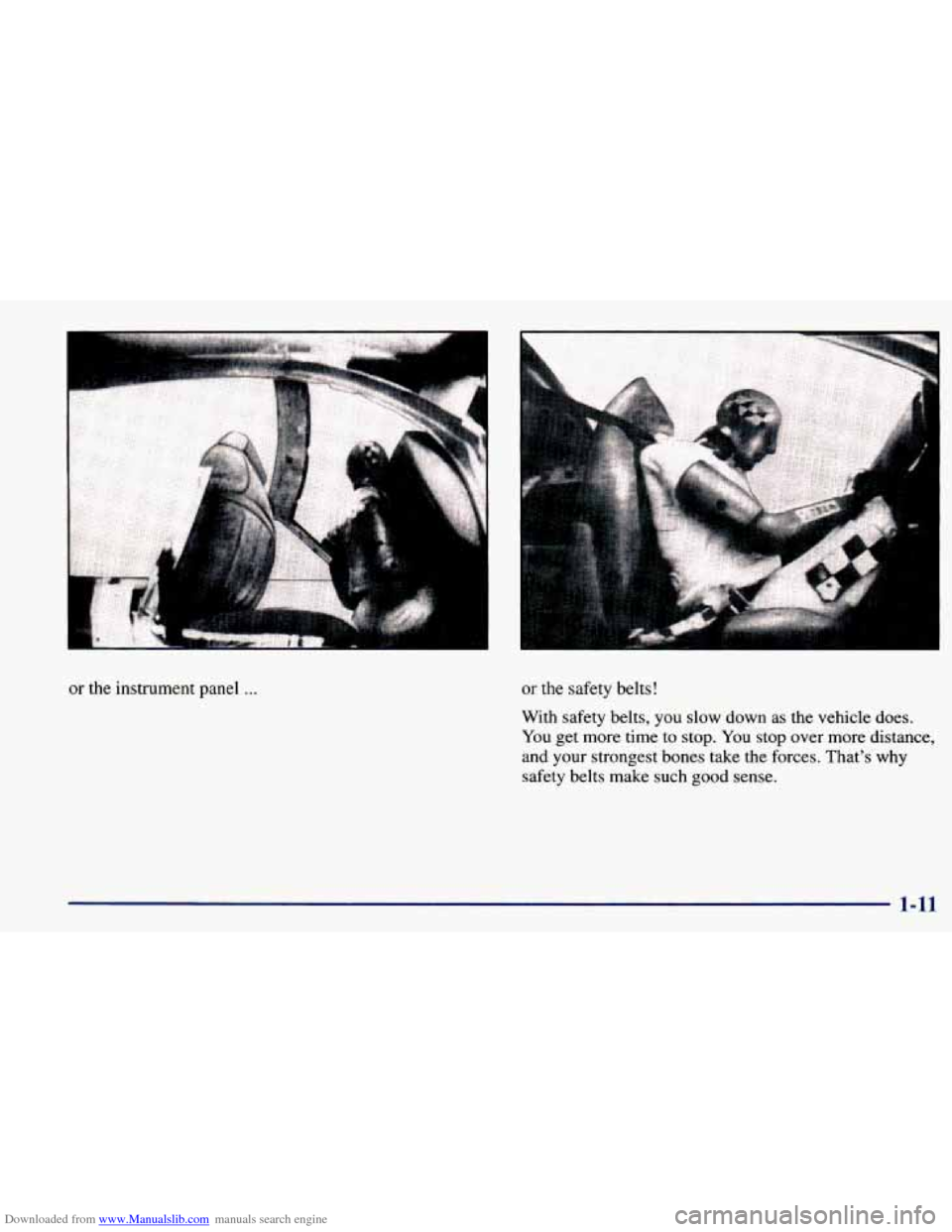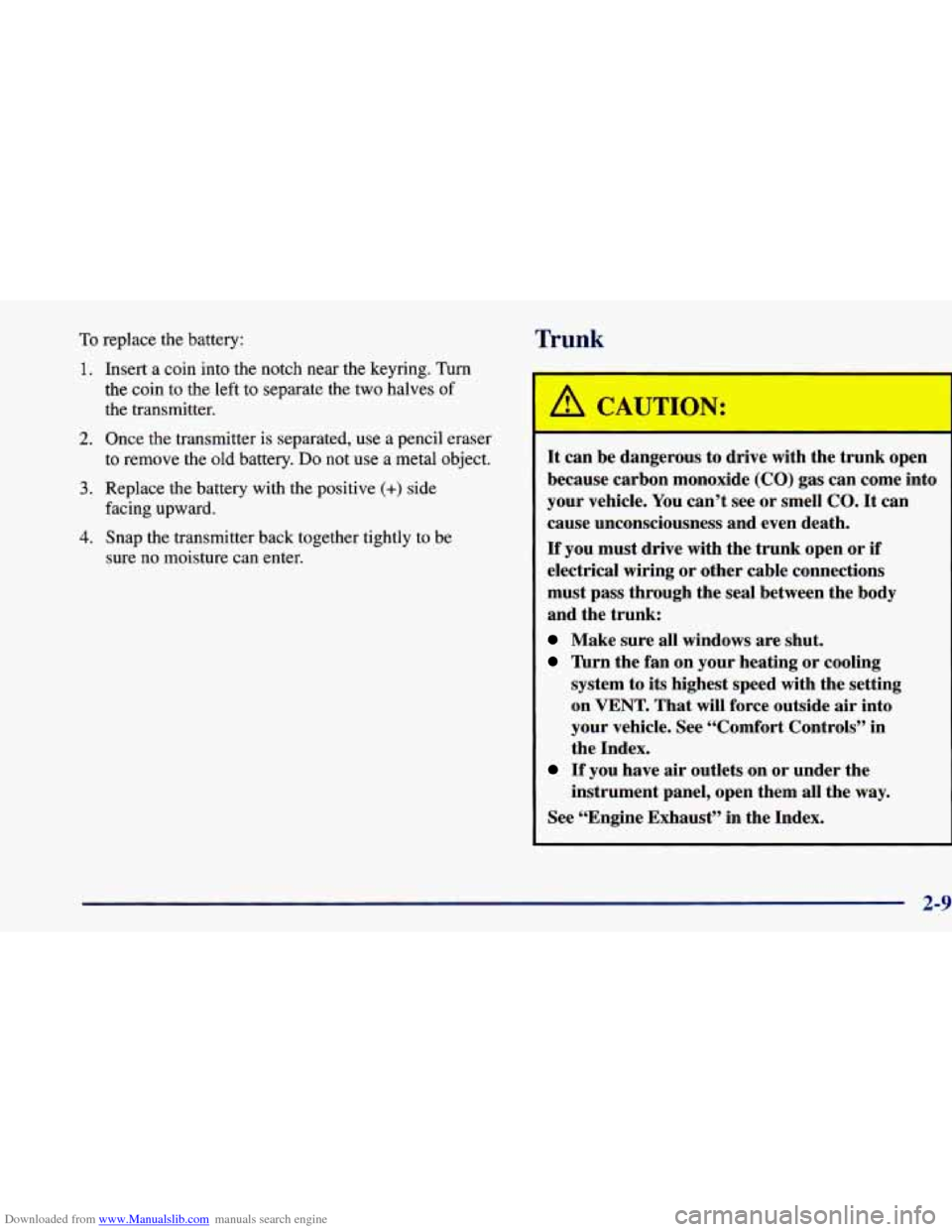1998 CHEVROLET PRIZM instrument panel
[x] Cancel search: instrument panelPage 25 of 364

Downloaded from www.Manualslib.com manuals search engine or the instrument panel ... or the safety belts!
With safety belts, you slow down as the vehicle does.
You get more time to stop. You stop over more distance,
and your strongest bones take the forces. That’s why
safety belts make such good sense.
1-11
Page 37 of 364

Downloaded from www.Manualslib.com manuals search engine A CAUTION:
Both frontal and side impact air bags inflate with
great force, faster than the blink of an eye.
If you’re
too close to an inflating
air bag, it could seriously
injure you.
This is true even with reduced-force
frontal
air bags. Safety belts help keep you in position
for
air bag idation before and during a crash.
Always
wear your safety belt, even with
reduced-force frontal
air bags. The driver should sit
as far back as possible while still maintaining control
of the vehicle. Front occupants should not lean on or
sleep against the door.
’ A CAU-ION:
Children who are up against, or very close to, an
air bag when it inflates can be seriously injured or
killed. This is true even though your vehicle
has
reduced-force frontal air bags. Air bags plus
CAUTION: (Continued)
I
lap-shoulder belts offer the best protection for
adults but not for young children and infants.
Neither the vehicle’s safety belt system nor its air
bag system is designed for them. Young children
and infants need the protection that a child
restraint system can provide. Always secure
children properly in your vehicle. To read how,
see the part of this manual called “Children” and
see the caution labels on the sunvisors and the
right front passenger’s safety belt.
AIR
BAG
There is an air bag
readiness light on
the instrument
panel, which shows
AIR BAG.
The system checks the air bag electrical system for
malfunctions.
The lights tell you if there is an electrical
problem. See “Air Bag Readiness Light” in the Index
for more information.
1-23
Page 38 of 364

Downloaded from www.Manualslib.com manuals search engine How the Air Bag Systems Work
Where are the air bags?
The driver’s frontal air bag is in the middle of the
steering wheel. The
right front passenger’s frontal air bag is in the
instrument panel on the passenger’s side.
The driver’s side impact air bag is in the side
of the
driver’s seatback closest to the
door.
1-24
Page 40 of 364

Downloaded from www.Manualslib.com manuals search engine When should an air bag inflate?
The driver’s and right front passenger’s frontal air bags
are designed to inflate in moderate to severe frontal or
near-frontal crashes. The frontal air bags are designed to
inflate only if the impact speed is above the system’s
designed “threshold level.”
If your vehicle goes straight
into a wall that doesn’t move
or deform, the threshold
level is about
1 1 to 15 mph (1 8 to 24 km/h). The
threshold level can vary, however, with specific vehicle
design,
so that it can be somewhat above or below this
range. If your vehicle strikes something that will move
or deform, such as a parked car, the threshold level will
be higher. The driver’s and right front passenger’s
frontal air bags are not designed to inflate in rollovers,
side impacts, or rear impacts, because inflation would
not help the occupant.
The driver’s and right front passenger’s side impact air
bags are designed to inflate in moderate to severe side
crashes involving a front door.
A side impact air bag
will inflate if the crash severity is above the system’s
designed “threshold level.’’ The threshold level can vary
with specific vehicle design. Side impact air bags are
not
designed to inflate in frontal or near-frontal impacts,
rollovers or rear impacts, because inflation would not
help the occupant.
A side impact air bag will only
deploy
on the side of the vehicle that is struck. It is
possible that, in a crash involving the front of
your vehicle, only one of the two frontal air bags in
your vehicle will deploy. This
is rare, but it can
happen in a crash just severe enough to make a
frontal air bag inflate.
In any particular crash, no one can say whether an
air bag should have inflated simply because of the
damage
to a vehicle or because of what the repair
costs were. For frontal air bags, inflation is determined
by the angle of the impact and how quickly the vehicle
slows down in frontal and near-frontal impacts. For
side impact air bags, inflation is determined by the
location of the impact and how quickly the side of the
vehicle deforms.
What makes an air bag inflate?
In an impact of sufficient severity, the air bag sensing
system detects that the vehicle is in a crash. For both
frontal and side impact air bags, the sensing system
triggers a release of gas from the inflator, which inflates
the air bag. The inflator, air bag and related hardware
are all part
of the air bag modules inside the steering
wheel, instrument panel and the side of the front
seatbacks closest to the door.
1-26
Page 41 of 364

Downloaded from www.Manualslib.com manuals search engine How does an air bag restrain?
In moderate to severe frontal or near frontal collisions,
even belted occupants can contact the steering wheel or
the instrument panel. In moderate to severe side
collisions, even belted occupants can contact the inside
of the vehicle. The air bag supplements the protection
provided by safety belts. Air bags distribute the force of
the impact more evenly over the occupant’s upper body,
stopping the occupant more gradually. But the frontal air
bags would not help you in many types of collisions,
including rollovers, rear impacts, and side impacts,
primarily because an occupant’s motion is not toward
the air bag. Side impact air bags would not help you in
many types of collisions, including frontal or near
frontal collisions, rollovers, and rear impacts, primarily
because an occupant’s motion is not toward those air
bags. Air bags should never be regarded as anything
more than a supplement to safety belts, and then only in
moderate to severe frontal or near-frontal collisions for
the driver’s and right front passenger’s frontal air bags,
and only in moderate to severe side collisions for the
driver’s and right front passenger’s side impact air bags.
What will you see after an air bag inflates?
After an air bag inflates, it quickly deflates, so quickly
that some people may not even realize
the air bag inflated. Some components
of the
air bag module -- the
steering wheel hub for the driver’s air bag, the instrument
panel for
the right front passenger’s bag, the side of the
seatback closest to the door for the driver and right front
passenger’s side impact air bags
-- will be hot for a short
time. The parts of the bag that come into contact with you
may be warm, but not too hot to touch. There will be
some smoke and dust coming from the vents in the
deflated air bags. Air bag inflation doesn’t prevent the
driver from seeing or being able to steer the vehicle, nor
does it stop people from leaving the vehicle.
A CAUTION:
When an air bag inflates, there is dust in the air.
This dust could cause breathing problems for
people with a history of asthma or other breathing trouble.
To avoid this, everyone in the
vehicle should get out as soon
as it is safe to do so.
If you have breathing problems but can’t get out
of the vehicle after an air bag inflates, then get
fresh air by opening a window or
a door.
1-27
Page 42 of 364

Downloaded from www.Manualslib.com manuals search engine In many crashes severe enough to inflate an air bag,
windshields are broken by vehicle deformation.
Additional windshield breakage may also occur from
the right front passenger air bag.
a
a
Air bags are designed to inflate only once. After an
air bag inflates, you’ll need some new parts for your
air bag system. If you don’t get them, the air bag
system won’t be there to help protect you in another
crash. A new system will include air bag modules
and possibly other parts. The service manual for your
vehicle covers the need to replace other parts.
Your vehicle is equipped with a diagnostic module,
which records information about the frontal air bag
system. The module records information about the
readiness of the system, when the sensors are
activated and driver’s safety belt usage at
deployment.
Let only qualified technicians work on your air
bag systems. Improper service can mean that an
air bag system won’t work properly. See your dealer
for service.
~ NOTICE:
’ If you damage the covering for the driver’s or
the right front passenger’s air bag, or the air bag
covering on the driver’s and right front
passenger’s seatback, the bag may not work
properly. You may have to replace the air bag
module in the steering wheel, both the air bag
module and the instrument panel for the right
front passenger’s air bag, or both the air bag
module and seatback for the driver’s and right
front passenger’s side impact air bag.
Do not
open or
break the air bag coverings.
1-28
Page 79 of 364

Downloaded from www.Manualslib.com manuals search engine a Section 2 Features and Controls
Here you can learn about the many standard and optional features on your vehicle, and information on starting,
shifting and braking. Also explained are the instrument panel and the warning systems that tell
you if everything is
working properly -- and what to do if you have a problem.
2-2 2-4
2-6
2-9
2-10 2-1
1
2-1 1
2-13 2- 14
2-18
2-20
2-2 1
2-23
2-24 Keys
Door Locks
Keyless Entry System (If Equipped)
Trunk
Theft
New Vehicle “Break-In”
Ignition Switch
Starting Your Engine
Automatic Transaxle Operation
Manual Transaxle Operation
Parking Brake
Shifting Into Park (P) (Automatic
Transaxle Only) Parking Over Things That Burn
Engine Exhaust 2-24
2-25
2-26
2-26
2-27
2-32
2-34
2-3
5
2-37
2-38
2-3
8
2-39
2-40
2-45 Running
Your Engine While You’re Parked
(Automatic Transaxle)
Windows
Horn
Tilt Column (Option)
Turn Signalhlultifunction Lever
Exterior Lamps
Interior Lamps
Mirrors Storage Compartments
Ashtrays and Lighter
Sun Visors
Sunroof (Option)
Instrument Panel
Warning Lights, Gages and Indicators
2-1
Page 87 of 364

Downloaded from www.Manualslib.com manuals search engine To replace the battery: Trunk
1. Insert a coin into the notch near the keyring. Turn
the coin to the left to separate the two halves
of
the transmitter.
2. Once the transmitter is separated, use a pencil eraser
to remove the old battery.
Do not use a metal object.
3. Replace the battery with the positive (+) side
facing upward.
4. Snap the transmitter back together tightly to be
sure
no moisture can enter.
It can be dangerous to drive with the trunk open
because carbon monoxide
(CO) gas can come into
your vehicle. You can’t see or smell
CO. It can
cause unconsciousness and even death.
If you must drive with the trunk open or if
electrical wiring or other cable connections
must pass through the seal between the body
and the trunk:
Make sure all windows are shut.
Thrn the fan on your heating or cooling
system
to its highest speed with the setting
on
VENT. That will force outside air into
your vehicle. See “Comfort Controls” in
the Index.
instrument panel, open them all the way.
If you have air outlets on or under the
See “Engine Exhaust” in the Index.
2-9